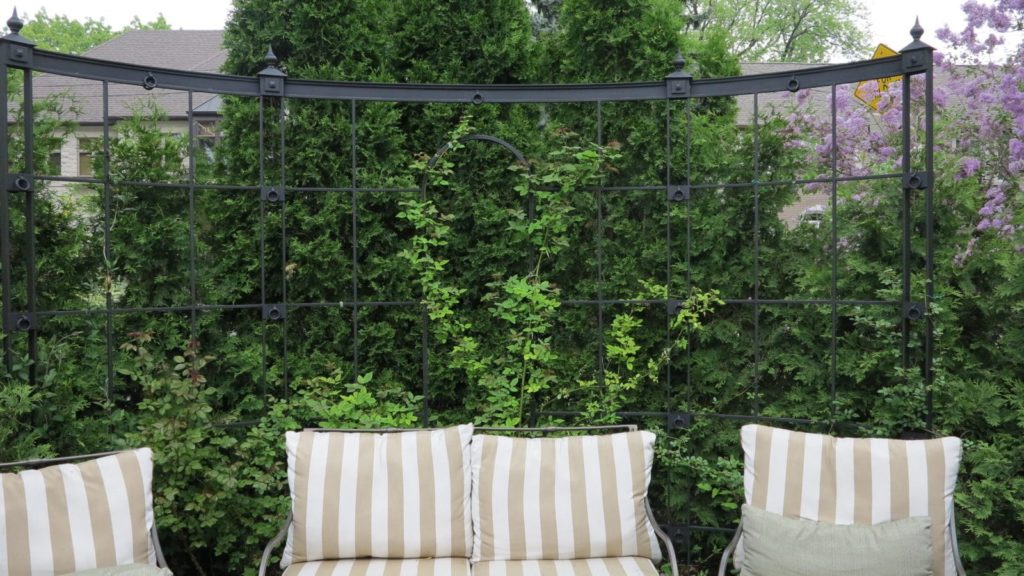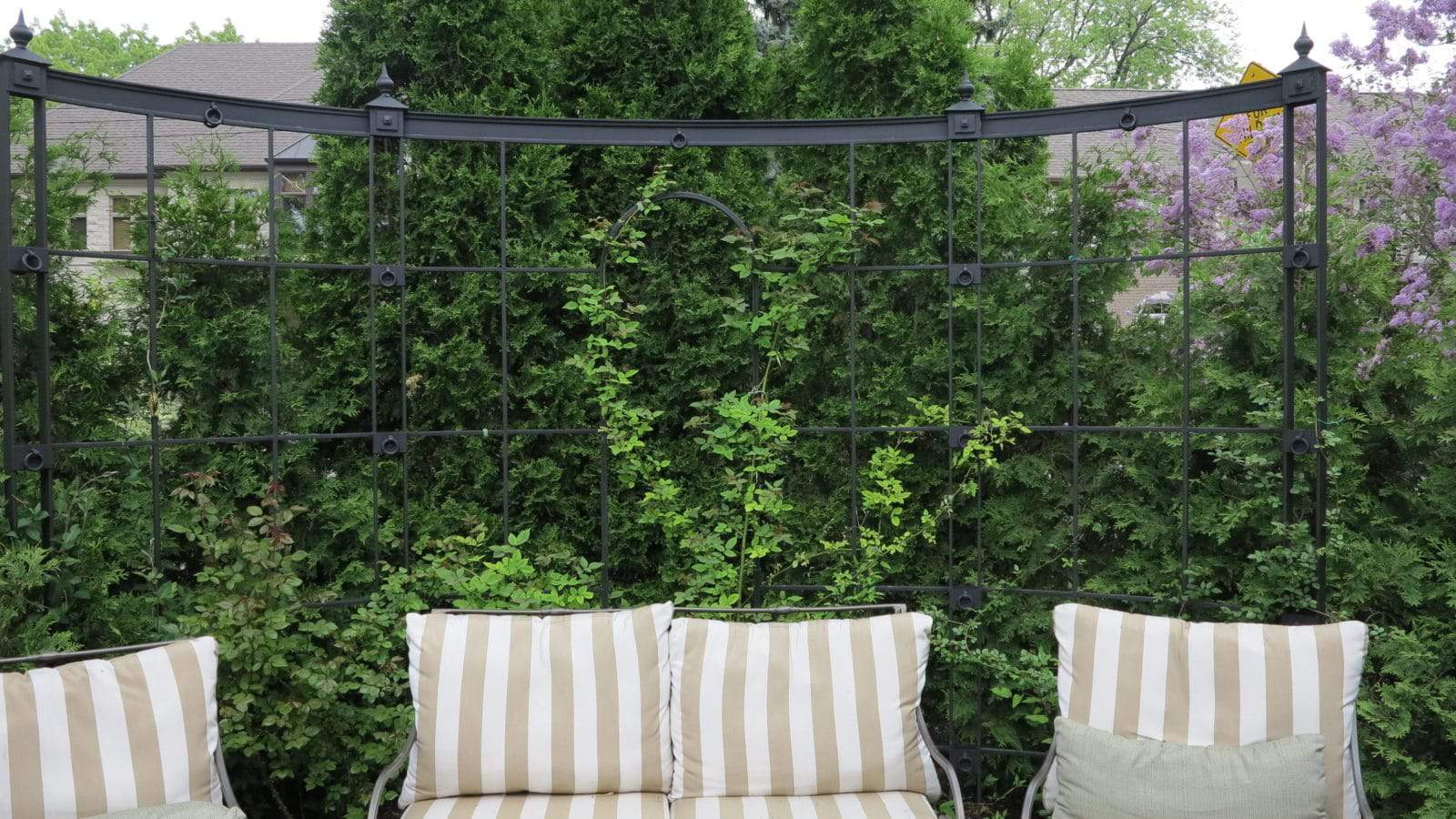
Screening an unattractive view can be a challenge, especially in a small garden. For example, if you have a long, narrow city garden and your next-door neighbour’s shed is not in great shape, what can you do to mitigate its impact on your lovingly designed beds and borders? In this example, a fence isn’t going to do the job. Most municipalities limit the height of fences to six feet (1.8 m) and an unattractive shed, garage or addition you want to block from view is taller than this. The most effective means of obscuring an eyesore is to plant tall, narrow deciduous or coniferous trees — often called columnar or fastigiate trees.
Whether you select a deciduous or coniferous tree is a matter of preference, but keep in mind a coniferous tree will screen the offending view year-round, while a deciduous tree will only be effective during the growing season.
Deciding what to plant depends on a few factors. You could opt for a mix trees for more variety and a more informal look. Or, you could plant several of one type of tree for a more unified, formal design. In most cases, trees need plenty of sun and well-draining soil to thrive.
Trees with a narrow, upright profile take up less space than specimens with an open, broad branching habit, and most columnar trees also have a low canopy, meaning branches start near the ground, affording more privacy. However, even though fastigiate trees are narrow, you still need to allow for some canopy width when they mature, so site them with this width in mind. Also, be sure their mature height won’t conflict with any power lines overhead.
Most nurseries offer the best selection in spring, which is also a good time to plant, because plants are still dormant. After leaf drop in fall is also a good time to plant. Container-grown trees can be planted throughout the season, although the height of summer heat can be stressful for transplants. Here are a few trees to consider.
5 deciduous trees for a sunny site
‘Bowhall’ red maple (Acer rubrum ‘Bowhall’) 50 x 15 feet (15 x 5 m)
This selection of a native species has red spring foliage that turns green for summer and then evolves into bright orange-red in fall. Zone 4
‘Dawyck Purple’ European beech (Fagus sylvatica ‘Dawyck Purple’) 60 x 20 feet (18 x 6 m)
Deep purple leaves all season; attractive smooth grey bark; low canopy. Needs consistent moisture. Zone 5
‘Princeton Sentry’ ginkgo (Ginkgo biloba ‘Princeton Sentry’) 60 x 30 feet (18 x 9 m)
Fan-shaped leaves turn bright yellow in fall; trees have a high canopy so better for screening distant views rather than a nearby eyesore. Zone 4
Columnar tuliptree (Liriodendron tulipifera ‘Fastigiatum’) 59 x 16 feet (18 x 5 m)
Cup-shaped, greenish flowers appear in late spring; four-lobed leaves turn yellow in fall. Zone 5
Pyramidal English oak (Quercus robur ‘Fastigiata’) 50 x 10 feet (15 x 3 m)
Low canopy; lobed leaves turn brownish green in fall, often remaining on tree through winter. Zone 5
3 coniferous trees for a sunny site
‘Slim Jim’ Norway spruce (Picea abies ‘Slim Jim’) 33 x 7 feet (10 x 2 m)
Stiff, short dark green needles. Zone 3
‘Iseli Fastigiata’ Colorado spruce (Picea pungens ‘Iseli Fastigiata’) 40 x 15 feet (12 x 5 m)
Selection of a native plant; bright blue needles on sharply angled branches; drought tolerant. Zone 2
‘Algonquin Pillar’ Swiss stone pine (Pinus cembra ‘Algonquin Pillar’) 25 x 10 feet (8 x 3 m)
Keeps its lower branches (unlike other pines); greenish-blue variegated needles. Zone 3
4 trees for semi-shade
Although the following trees prefer sun, they will tolerate semi-shade.
‘Flame’ Amur maple (Acer ginnala ‘Flame’) 20 x 20 feet (6 x 6 m)
Not truly a columnar shape, but a multi-stemmed tree with a low canopy that can be pruned into a narrower silhouette. (Prune in summer when leaves are full formed to prevent bleeding of sap.) Attractive winged fruit (samaras) in spring; bright crimson foliage in fall. Zone 3
‘Frans Fontaine’ European hornbeam (Carpinus betulus ‘Frans Fontaine’) 40 x 20 feet (12 x 6 m)
Shiny, pointed leaves; gold fall colour; attractive grey bark; low canopy. Zone 5
Persian ironwood (Parrotia persica) 43 x 30 feet (13 x 9 m)
Not a columnar tree, but one with a low canopy and upright branching habit. Best for a large space, but still suitable for screening. Glossy green leaves that turn orange, yellow and red in the fall; exfoliating bark. Zone 4
Emerald cedar (Thuja occidentalis ‘Smaragd’) 12 x 4 feet (3.5 x 1.2 m)
Usually planted in rows for a dense, finely textured, rich green hedge. Requires consistent moisture. Zone 4
Costs for trees and planting
How much a tree costs depends on its variety and size. Most large trees sold in a nursery are labelled by caliper, a measurement of the trunk’s diameter about 12 inches (30 cm) above ground. Generally, the larger the tree, the more expensive it will be simply because it takes more time to grow it to a larger size. However, don’t let the cost of a large tree discourage you from planting one altogether. Younger, smaller trees are less expensive, and have the added benefit of adjusting to transplanting quite well, soon catching up to larger specimens planted at the same time.
In addition to the cost of the tree, you may need to pay someone to plant it, especially if it’s sold with a large, heavy root ball. Prices for planting vary, depending on the size and also ease of access to the planting site. For example, Gauld Nurseries (gauldnurseries.com) in Niagara Falls, Ontario, generally charges $95 to plant a B&B tree, including mulch and delivery. In the Toronto area, Sheridan Nurseries (sheridannurseries.com) estimates delivery, planting and mulching a four- to five-foot (1.2- to 1.5 m) B&B or container-grown deciduous tree would cost between $200 and $250.
Trees are sold one of three ways:
- Bare-root: Dormant trees with no soil surrounding the roots. Fruit trees are often sold bare-root.
- Balled and burlapped (B&B): Root balls of field-grown trees are dug up and encased in burlap, then wrapped in heavy twine or a wire cage to keep the root ball intact. According to the International Society of Arboriculture, the diameter of the root ball should be at least 10 times the diameter of the trunk when measured six inches (15 cm) aboveground. Remove the twine or wire covering the burlap once the root ball is in the planting hole; also remove as much of the burlap as possible.
- Container grown: Roots and soil are contained in a plastic or fibreboard pot. The pot is removed when planting.


Excited to see this article however trees with a canopy of 7 ‘ is still too big for small gardens.. or side gardens.
I need a tree that can withstand full sun with a narrow root system. Which Japanese Maple would be suitable. It will be planted near a wall to screen out the blazing morning sun from my kitchen. Zone 5b?
Some of the other fast growing trees you can plant that are hearty for cold & warm climates are: Willow hybrids (6ft/year and full coverage), hybrid Poplars (about 7-9ft/year), and Leyland Cypresses (3-5ft/year, but very full all the way up). Each of them will grow over 30-50 feet if allowed to, and are great for privacy from neighbouring dwellings.
Hi,
Can you specify the growth rates of some of these trees?
Thanks
An excellent question. The only fast-growing tree listed is ‘Fastigiatum’ tulip tree. The following three grow at a medium rate: ‘Bowhall’ red maple; ‘Flame’ Amur maple; and Emerald cedar. All of the others listed would be considered slow-growing trees.